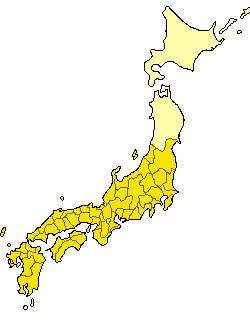 | ||
The Taiho Code or Code of Taiho (大宝律令, Taihō-ritsuryō) was an administrative reorganization enacted in 703 in Japan, at the end of the Asuka period. It was historically one of the Ritsuryō-sei (律令制, ritsuryō-sei). It was compiled at the direction of Prince Osakabe, Fujiwara no Fuhito and Awata no Mahito. The work was begun at the request of Emperor Monmu and, like many other developments in the country at the time, it was largely an adaptation of the governmental system of China's Tang dynasty.
Contents
- Governmental organization
- Provincial organization and administration
- Chinese influence
- Chronology
- References
The establishment of the Taihō Code was one of the first events to include Confucianism as a significant element in the Japanese code of ethics and government. The Code was revised during the Nara period to accommodate certain Japanese traditions and practical necessities of administration. The revised edition was named the Yōrō Code (養老律令, Yōrō-ritsuryō). Major work on the Yōrō Code was completed in 718. However, for some elements of the Code, Chinese logic and morals were taken to extremes.
The Taihō Code contained only two major departures from the Tang model. First, government positions and class status were based on birth, as had always been the Japanese tradition, not talent, as was the Chinese way. Second, the Japanese rejected the Chinese concept of the "Mandate of Heaven," asserting that the Emperor's power comes from his imperial descent, not from his righteousness or fairness as a ruler.
This code is said to be based on the Code of Yonghui (永徽律令, Yonghui lu ling), enacted in 651 by the Chinese (Emperor Yonghui).
Governmental organization
The Taihō Code established two branches of government: the Department of Worship (神祇官, Jingi-kan) and the Department of State (太政官, Daijō-kan). The Jingi-kan was the higher branch, taking precedence over the Daijō-kan and handled all spiritual, religious, or ritualistic matters. The Daijō-kan handled all secular and administrative matters.
The Jingi-kan, or Department of Worship, was responsible for annual festivals and official court ceremonies such as coronations, as well as the upkeep of shrines, the discipline of shrine wardens, and the recording and observation of oracles and divinations. It is important to note that the department, though it governed all the Shintō shrines in the country, had no connection with Buddhism.
The Daijō-kan, or Department of State, handled all secular matters and was headed by the Great Council of State, which was presided over by the Daijō-daijin (太政大臣, Chancellor). The Ministers of the Left and Right (Sadaijin 左大臣 and Udaijin 右大臣 respectively), Controllers of the Left and Right (Sadaiben 左大弁 and Udaiben 右大弁), four Great Councillors (Dainagon 大納言) and three Minor Councillors (Shōnagon 少納言) made up the Council, and were responsible to the Daijō-daijin. The eight government Ministries were, in turn, responsible to the Controllers and Ministers of the Left and Right.
Provincial organization and administration
The country was divided into provinces called kuni (国), and the central government appointed administrative governors, kokushi (国司), divided into four levels (the Shitōkan), kami, suke, jo and sakan to each province. The provinces were further divided into districts called gun (郡) or kōri, which were administered by locally appointed officials called gunji (郡司). These local officials were primarily responsible for keeping the peace, collecting taxes, recruiting labor for the corvée, and for keeping registers of population and land allotment. Within the districts' further subdivisions, local organization varied greatly, but often resembled the arrangement of a township of fifty or so homes led by a headman.
The number of provinces was not fixed, however. As new land was developed, new provinces came into being. At the time of the Code's enactment, there were sixty-six provinces comprising 592 districts.
Chinese influence
The Chinese system known as ritsuryō in Japan was adopted by both the kingdoms of the Korean peninsula and Japan at the same time.
According to Shoku Nihongi, the participation member of Taihō Code was the 18 Japanese aristocrats and one Chinese scholar (薩弘恪 Satsu Koukaku) Chinese scholar Satsu played an important role. He participated in the edit of Nihon Shoki, and often received the reward from the Japanese emperor.
Chronology
Current understanding of the conditions which preceded the Taihō reforms remains replete with unanswerable questions, but there is much which can be inferred—for example:
Any examinations of the earliest known texts become exercises in historiography—for example:
Although essential as a starting point, any list of serial events will reveal only part of the unfolding story - for example:
